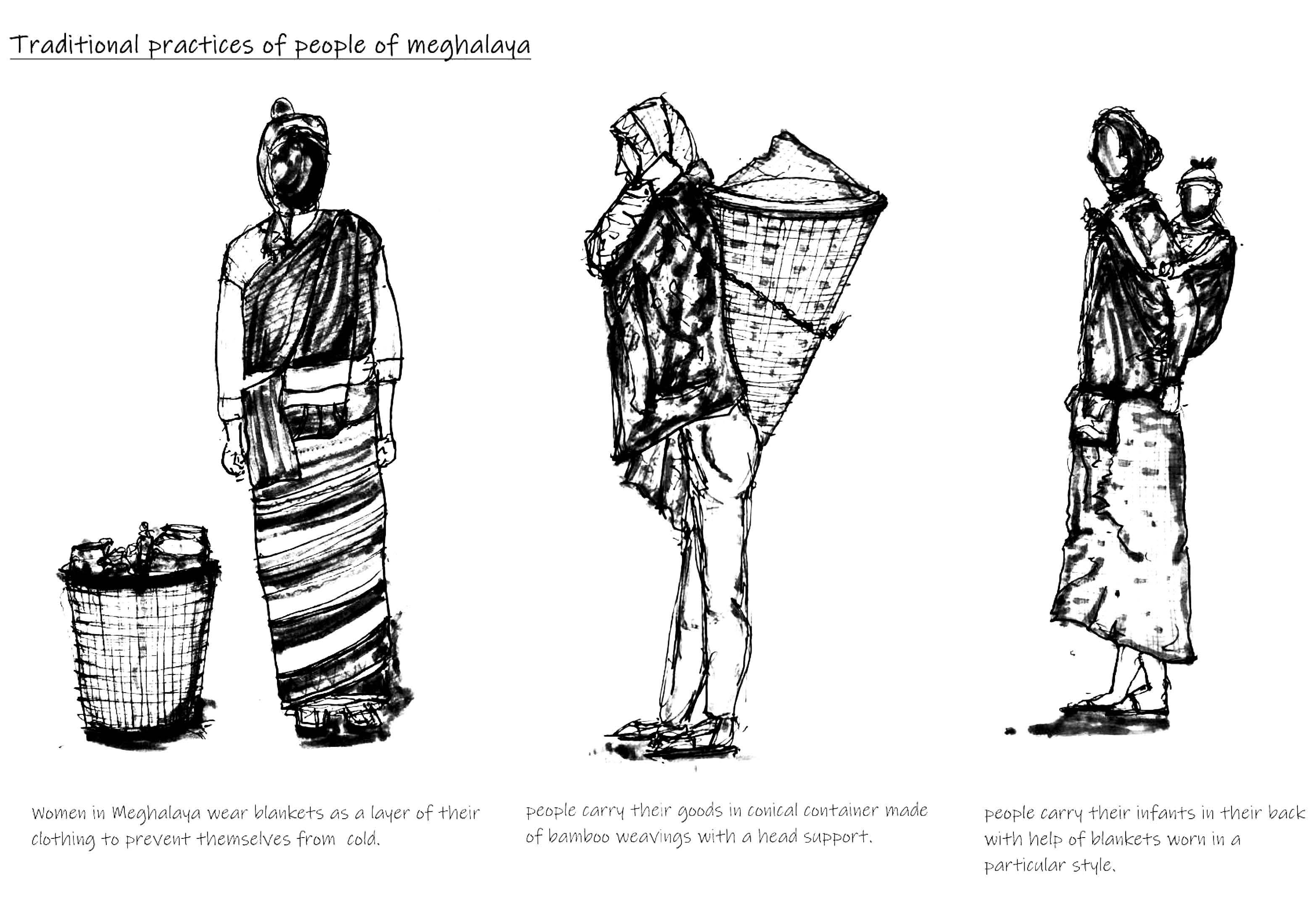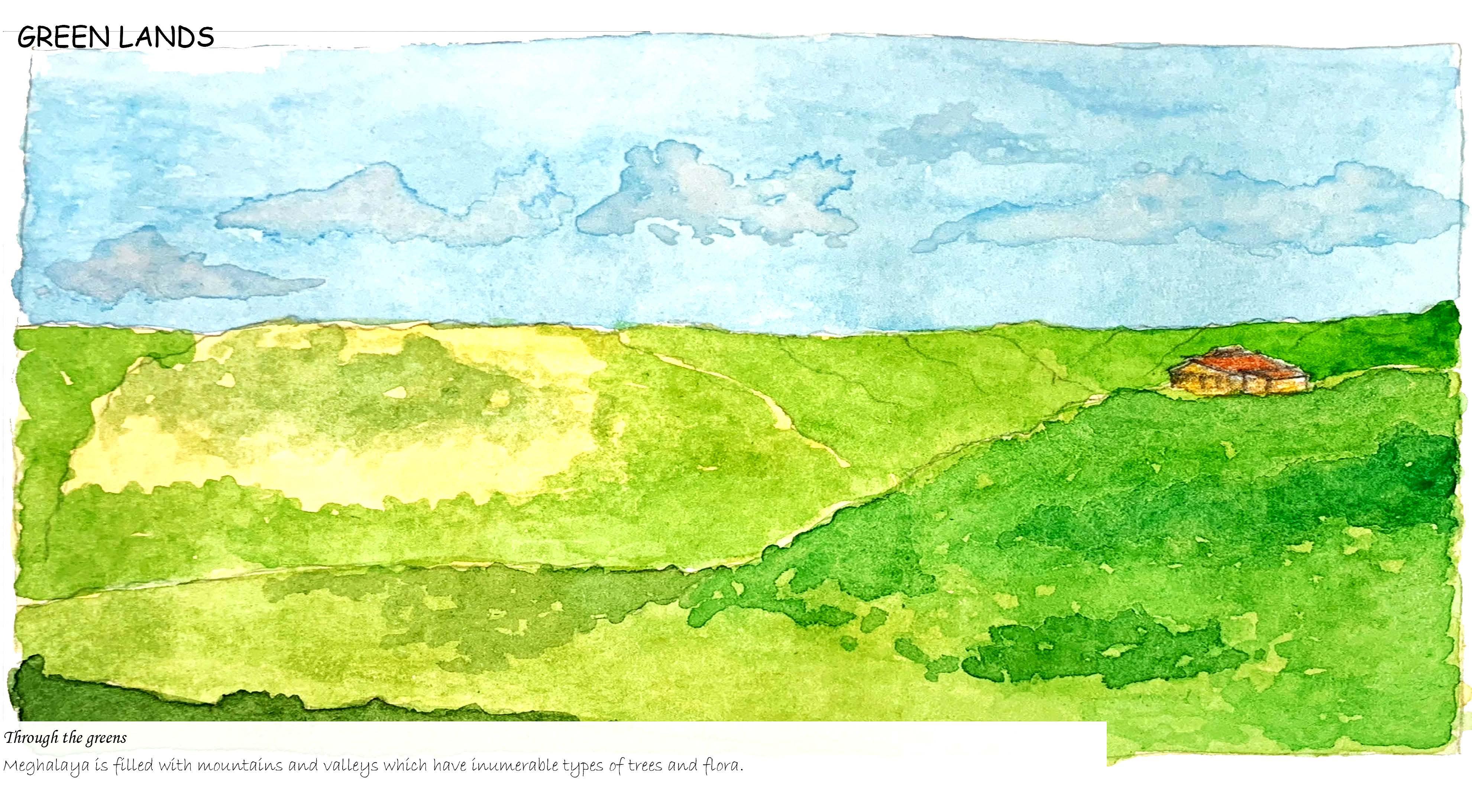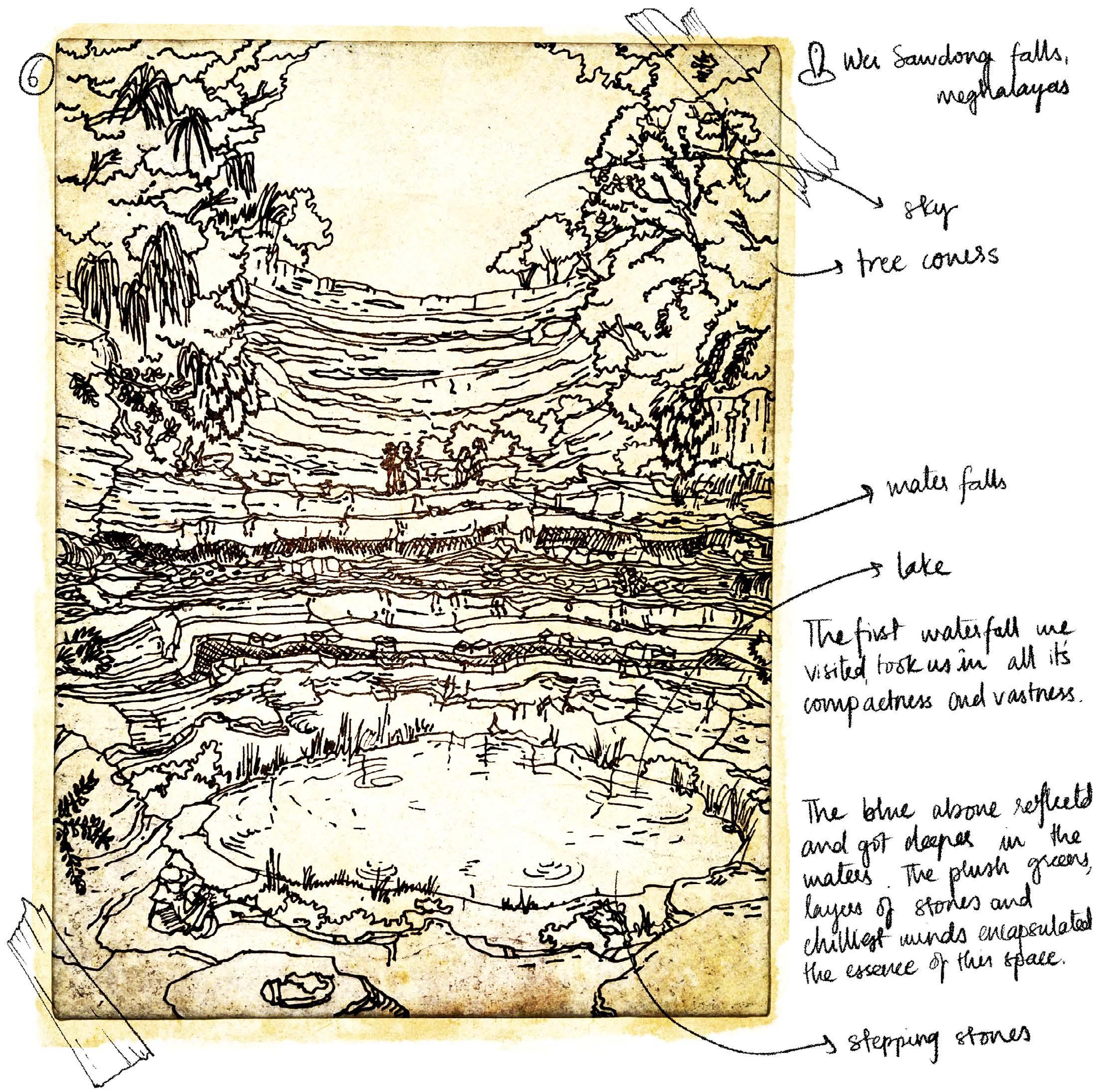
STUDENTS:
ARINARAYANAN M
AASTHA MARAVIYA
BRINDA JASOLIYA
DARSHAN PATEL
DAKSH TAK

DEEPAK N.
DIVIJA PATEL
DIVYA SHAH
JHENEE MEHTA
MAULIK SONI
MANSI SINGH
KATEPALLI VARSHINI
KHUSHI PATEL
KRUNAL SADHU
PRACHI SURANA
RIDDHI GONDALIYA
SRIBASCHHA SRITANU LENKA
VAIDEHI CHIKHALIA
Course Tutor
An academician, a practising architect, and a landscape architect. Currently she is a visiting faculty member at CEPT University (Faculty of Architecture), Ahmedabad, and Navrachana University (School of Environment, Design, and Architecture), Vadodara. Beside this, she is a passionate urban sketcher and invests a lot of time in making travel sketchbooks. Her teaching interest lies in subjects dealing with representation and communication through architectural drawings. She finished her Bachelor in Architecture in 2013, followed by a Masters in Landscape Architecture in 2015 from CEPT University. Currently she is pursuing her PhD in Landscape Architecture at the School of Planning and Architecture (SPA), Delhi.
Email ID: priyanka.kanhare@cept.ac.in la.p.kanhare@gmail.com
Instagram handle: @priyanka.kanhare
Journaling, as a narrative medium, is a way to express experiences/ stories/memories of all the intangible associations that one has or deve lops by occupying a space over a period of time. This eventually transforms them into powerful meaningful places that have stories to tell and worth documenting. Most Indian cities have a rich “Cultural heritage” which includes traditions or living expressions inherited such as oral traditions, performing arts, social practices, rituals, festive events, etc. (as stated by UNESCO). As inhabitants of such city, we associate with people and places and think what we experienced have some significance. While doing so, we have memories of particular times, people and places that connect emotionally. The most common method of documenting is either by making architectural drawings or taking photographs. In doing so, often these narratives become two dimensional, “flat” representations. Hence through the medium of journaling, one can develops a unique language of representation, which is a multiple-layered representation that takes one back and forth in time.

The course was scheduled for 10 days in December, 2022. It began with introduction to the course, followed by presentation addressing importance of representation and visual narratives in design fields. The first assignment was then put forth, where each of the student/ professional was assigned to make a storyboard narrating their strongest association with objects, places, buildings, routes, or activities in their neighbourhood. Students were also exposed to works by various architects, urban sketchers, artist, illustrators, etc., who had different techniques of representations and used varied mediums. The main assignment for the course was where each student/professional was asked to decide up an intangible experience or memory that they wanted to translate into a visual narrative for their past travel to a specific place.
On reaching Meghalaya, we travelled between three places: Shillong, Cherrapunji, and Shnongpdeng (Dawaki River, India-Bangladesh border).
During the travel, students picked up various themes such as landscape and buildings, socio-economic practise and occupation, traditional and religious practices, food, clothing, building materials, vernacular practices, etc. They narrated stories and associations that people had with each of the three places mentioned above, and these stories were narrated through the medium of photography and illustrations, storyboards, etc.
About Meghalaya

Northeast India’s Meghalaya, which means “abode of clouds,” is a state. On January 21, 1972, Meghalaya was created by dividing the state of Assam into two districts: Khasi Hills and Jaintia Hills; and the Garo Hills. The size of Meghalaya is roughly 22,430 square kilometres. Mymensingh and Sylhet in Bangladesh, Rangpur in Bangladesh, and the State of Assam in India form the state’s southern, western, and northern borders, respectively. Shillong serves as Meghalaya’s capital. India was known as the “Scotland of the East” by British imperial rulers throughout their time in power. Meghalaya’s official language is English. The youngest daughter in Meghalaya, unlike many other Indian states, gets all of the riches and is also responsible for caring for her parents. Meghalaya has long practised a matrilineal system where the lineage and inheritance are tracked through women. The state is the wettest in all of India, with the southern Khasi Hills registering the highest average annual rainfall at 12,000 mm (470 in). The state has forests covering over 70% of its area. The state is entirely covered by the Meghalaya subtropical forests ecoregion; its mountain forests are unique from the tropical lowlands to the north and south. The diversity of the woodlands’ mammals, birds, and flora is noteworthy. The economy of Meghalaya is mostly agrarian, with a significant commercial forestry sector. Potatoes, rice, maize, pineapple, banana, papaya, and spices are key crops. Real estate and insurance firms make up the service industry. Despite having a geologically rich mineral wealth, the state lacks any notable industries. There are roughly 1,170 kilometres (730 mi) of national highways in the state. It serves as a significant logistical hub for trade with Bangladesh. The late Holocene was referred to as the Meghalayan stage/age by the International Council on Stratigraphy in July 2018 because a speleothem in Mawmluh cave that indicates a significant global climate event around 2250 BCE had been selected as the boundary stratotype.

Points of encounters....

1. Khasi Hills and Umiam Lake

2. They tried local dishes at the local dhaba.
3. The taste of the organically grown oranges and pineapple is just wow here.
4. The Grand Canyon of India—Laitlum Witnessed the cloud movement in the valley
5. travelling towards Jayantia Hills
6. First, trek for 25 minutes along bamboo stretches to reach a beautiful, three-layered waterfall named Wei Sawdong. The blue waters of Wei Sawdong were beyond words.
7. jouney to Tyrna Village, in Cherrapunji
8.2 seconds and a very difficult one—3000 “steps” to a single-root bridge.
9. Heading ahead, we trekked 3000 more steps to reach “Double Decker Root Bridge”, where there was a small waterfall of Nongriat and the 500-year-old double-decker bridge (one of its kind).
10. witnessed the highest waterfalls: Nokalikai
11. travelling across the forested areas on the Indo-Bangladesh border.
12. reaching Shnongpdeng river camp, and rested along the pristine and most clear water river named Dawaki...
13. head back to Shillong, but on the way, witness a beautiful fall with lush greenery around: Krangsuri Falls.
14. Shillong Local travel: traversing through the town, houses, and streets with various shops and
15. Police Bazaar, Shillong: we explored the charming city and its famous market. Amazing eating joints, and cultural reference
16. A sudden surprise: “Winter Tales,”, an event that can give the Christmases in any other part of the world a strong competition. Witnessed local artisans, bamboo crafts, food, music, etc. What an end!
Umiam lake (on the way to Shillong)
A reservoir called Umiam Lake is located in the hills to the north of Shillong, Meghalaya, India. The Assam State Electricity Board constructed Umiam Dam, which encloses the lake, in the early 1960s. The dam was built with the intention of storing water for the production of hydroelectric power. The first reservoir-storage hydroelectric plant in northeastern India was commissioned as Umiam Stage I. Later, three further phases of the Umiam Project were constructed downstream. The lake not only stores water for use in power production, but it also offers a wide range of ecosystem services at the micro, meso, and macro scales. Local anthropogenic demands are met by irrigation, fisheries, and drinking water downstream. On the route to additional hills, this was my first experience with the magnificent beauty of Meghalaya.
Khasi hills and the changing landscape





In the Shillong Plateau in the Indian state of Meghalaya, there is a low mountain range known as the Khasi Hills. The Garo-Khasi-Jaintia range includes the Khasi Hills, which farther east link to the Purvanchal Range and the greater Patkai Range. The Khasi Hills and the entire Garo-Khasi-Jaintia range are part of the ecoregion of Meghalaya’s subtropical forests. Formerly living in several chieftainships, the Khasi Hill States are populated mostly by tribal Khasi inhabitants. Sohra, one of its capitals, is regarded as one of the wettest regions on earth. Presbyterianism is practised by the majority of Khasis, followed by Catholicism and Anglicanism. Lum Shyllong, which rises to a height of 1,968 metres (6,457 feet), is the tallest summit. A few kilometres south of Shillong town is where it is located.
Football being the regional sport for them, most colleges and school have their own football ground. In many places small forest areas are cleared to create grounds.
Interestingly, when we went to Shillong, it was the final match-of FIFA 2022 world cup, and after the wining of Argentina, people came out celebrating, like the way we celebrate cricket wins and world-cup.

The regional food of Meghalaya, an Indian state, is known as meghalayan cuisine. Three tribes call Meghalaya home, and it has a distinct cuisine from the other Seven Sister States in northeast India. On the way, one would come across stalls with fresh fruits that are grown on the slopes of this region. Also, bamboo being a locally cultivated edible plant, people make bamboo pickles and sell them in small jars.

local food of the region




Meghalayan cuisine: The basic meal of the population is rice with spicy prepared meat and seafood. They raise cows, pigs, chickens, ducks, goats, and other animals for their delicious meat. Pickled bamboo shoots, jadoh, ki kpu, tung rymbai, and other delicacies are favourites of the Garos, as well as the Khasis and Jaintia. Both domesticated and wild animals are consumed by the Garo people, but their daily mainstays are straightforward dishes like rice with kapa that are prepared with a specific spice called purambhi masala. But sometimes, if you are lucky, you can get vegetarian food as well, with sabji, rice, papad, and dal.

Laitlum Canyons : Grand canyon of India


The ideal location to experience expansive, panoramic, and gorgeous views of the state of Meghalaya is Laitlum Canyons.



Literally translated as “end of the earth” or “end of hills,” Laitlum Canyons is a region. It is roughly 45 kilometres from Shillong, the metropolis. The area provides lengthy, rugged, and lush green hikes, so trekkers, adventure enthusiasts, and thrill seekers may have a great time. While a little challenging to travel, the terrain gives the greatest views. The only way to go from the town to the closest market is via a steep staircase on the mountainside that has roughly 3,000 steps. The spot is best visited in the afternoon because the mornings are typically foggy and make it difficult to appreciate the vista.







Here you will find “red lemon tea”, maggie, sweet corn, purple radish, etc. Locals in this area built their own restaurants and home stays with locally available bamboo and wood. You will find everything that is required for life, but no exploitation of nature. We spent time eating and sketching.

On they way we came across a goat...


Some students used creative ways to record their observations and generate narratives. They spoke with locals, travelled the most difficult treks, and ate local food. One student tried her hands on a small stamp-sized sketchbook, while another tried to make a travel vlog.








Jaintia hills, Meghalaya

One of Meghalaya’s 11 (eleven) districts is the West Jaintia Hills District. West Jaintia Hills District was created on July 31, 2012, with its administrative centre at Jowai, when the previous Jaintia Hills District was split into East and West Jaintia Hills Districts. The West Jaintia Hills Region has a particularly soothing and pleasant environment. Neither the summer nor the winter are unbearably hot or cold. The south-west monsoon, which typically begins in the middle of May and fades near the end of September, has a relatively high rainfall profile. The West Jaintia Hills District is the home of the “Jaintias,” one of the main tribes of Meghalaya.
The Jaintias are said to be survivors of the initial Mongolian flood into India, similar to the Khasis. They arrived in their current country long ago, and thanks in large part to their geographic isolation, they were able to hold on to their independence until the British rule in this region of India consolidated. The Jaintias live in a matrilineal culture, a very uncommon and distinctive practise in which the children derive their identity or family title only from the mother.
People from Jaintia are renowned for their ability to weave and for producing cane mats, stools, and baskets. They are also well known for producing musical instruments, jewellery, and items made of pineapple fibre in addition to weaving silk and carpet. They produce textiles as well. a variety of outfits worn by both men and women in this neighbourhood. They encompass both daily clothes and attire worn for special occasions. The Meghalaya subtropical forest ecoregion includes the district. Amlarem Subdivision’s Krangshuri Waterfall is a popular tourist destination (War-Jaintia).
While travelling along the valley, one would come across mountains that were cut or broken down for extracting stone. Large crevices have been formed up to the core of the mountains, resulting in major landslides during the monsoon. Interestingly, it also means more land is being cleared for infrastructure development. The future of the valley needs to be monitored very strictly!



Wei Sawdong waterfall, Cherrapunji, Meghalaya


At Cherrapunji, Meghalaya, there is a three-tiered waterfall called Wei Sawdong Falls. The waterfall is located in the East Khasi Hills area, some 60 kilometres southwest of Shillong, and is not far from Dainthlen Falls, another significant waterfall. The indigenous language of Khasi is where the term Wei Sawdong originates. Wei Sawdong is tough to reach, and the hike to the waterfall is via a strenuous out-and-back walk. The water near the falls is particularly renowned for being bluish-green and transparent.

On the way back, we saw a boulder (we think so!), and it was big, lying on the rock, and we were not sure if it was dead or alive! We thought we could pick it up and put it in a jar and see if it was alive!







“Amidst the lush green hills of Meghalaya, I set out on a sketching trip one day. With my canvas, colors, and brushes in hand, I was ready to capture the beauty of this land. The rolling hills and valleys so serene, A sight to behold, like nothing I’ve seen. The clouds floating low, the misty air, It felt like I was in a painting fair.

I found a spot to set up my gear, And started sketching without any fear. The sun was shining bright up above, But the cool breeze made it feel like love. The chirping birds and buzzing bees, Added to the symphony of the trees. The sound of the flowing river nearby, Was like a sweet lullaby.
As I painted, I felt like I was in a trance, Lost in the beauty, in a moment of chance. The colors on my canvas started to blend, As if the scene was coming to life, my friend.
As the day drew to a close, I packed up my gear and struck a pose. I looked at my sketch, and it looked back, A beautiful memory, forever intact.
Meghalaya, a land so blessed, Nature’s canvas, at its very best. I’ll cherish this sketching trip forever, A memory that I’ll always treasure.”
- Divya Shah